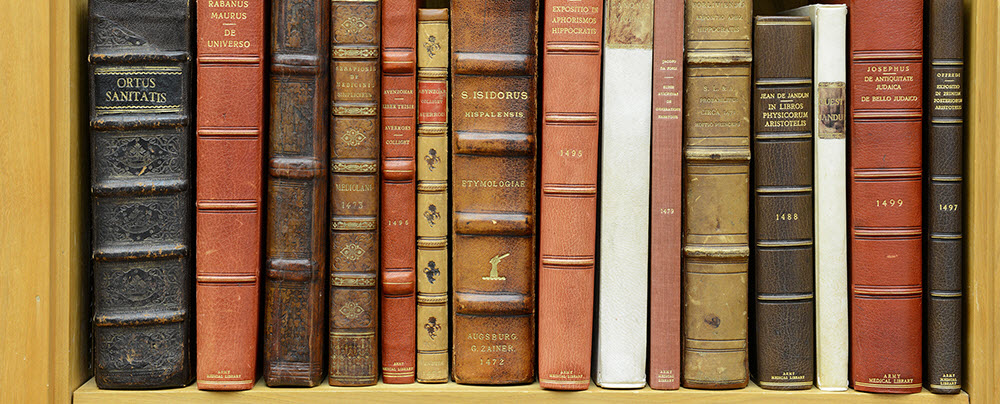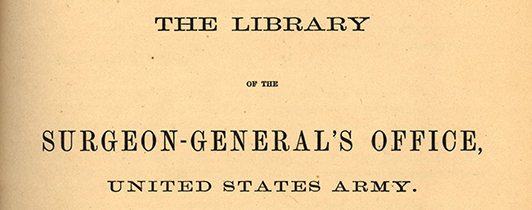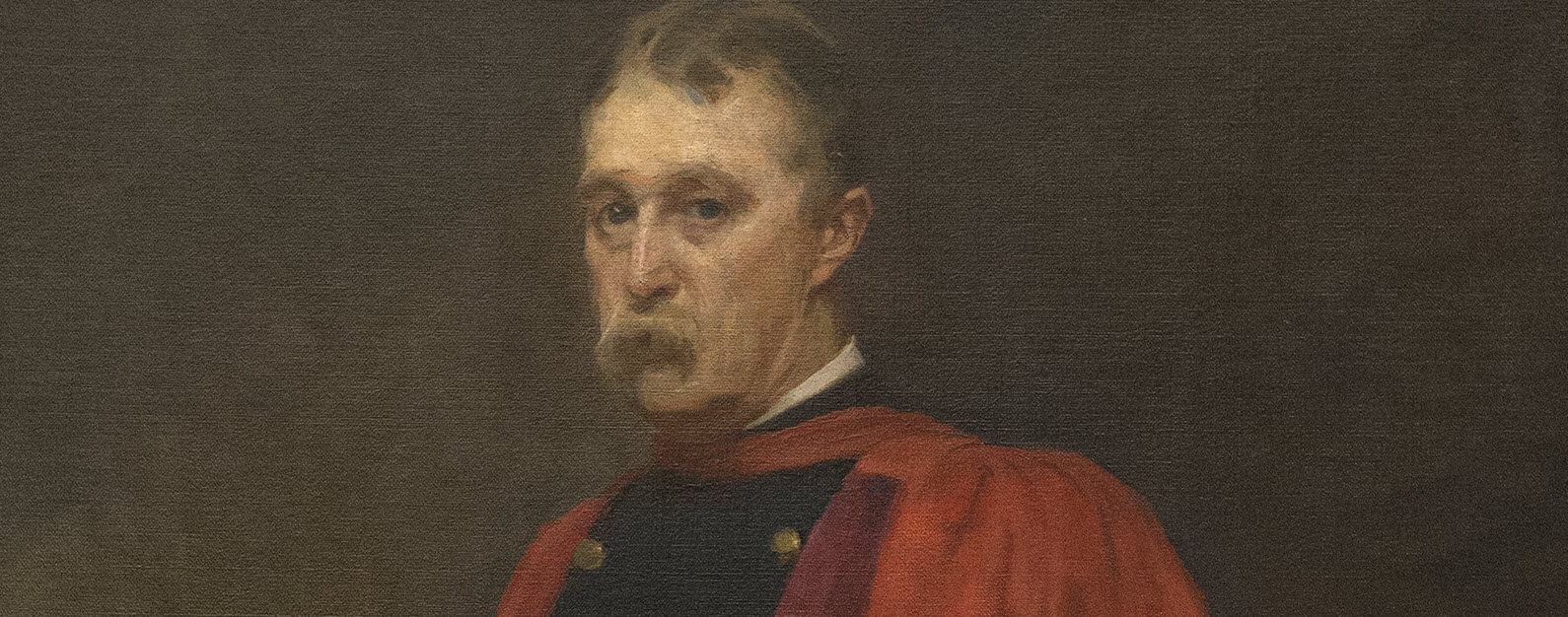The elements and attributes described in this document are defined in the IndexCatalogueRecordSet.dtd and are used in the IndexCatalogue XML output files. The IndexCatalogueRecordSet.dtd is available at https://www.nlm.nih.gov/databases/dtd/nlmindexcataloguerecordset_130401.dtd
An alphabetical list of all element names and their attributes in the IndexCatalogueRecordSet.dtd is available at https://www.nlm.nih.gov/hmd/indexcat/ic_elements_alphabetical.html
Structure of the IndexCatalogueRecordSet.dtd:
The IndexCatalogueRecordSet.dtd defines a XML structure for records in the Index-Catalogue collection. At the highest level, the DTD requires a root element named "IndexCatalogueRecordSet". The <IndexCatalogueRecordSet> root element is comprised of one or more instances of the top-level <IndexCatalogueRecord> element, and may optionally contain one instance of the top-level <DeleteIndexCatalogueRecord> element.
The <DeleteIndexCatalogueRecord> element is present in the <IndexCatalogueRecordSet> when records have been deleted from the Index-Catalogue collection. The <DeleteIndexCatalogueRecord> element contains only the unique identifier of each deleted record and is defined more fully at the end of this document.
Structure of the element descriptions in this document:
Following a description of <IndexCatalogueRecord> parent element, this document continues with descriptions of its 15 child elements based on the alphabetical order of the IndexCatalogue XML file. The <IndexCatalogueRecord> child elements are numbered for convenience and readability.
Each of the 15 numbered sections includes the following information, if applicable:
- Required indicates Yes/No whether or not the element is required to appear within its parent envelope
- Repeatable indicates Yes/No whether or not the element can be repeated within its parent envelope
- Attributes are applied to an element to provide additional information about that element
- Child elements are elements contained within a parent element envelope
- A brief description of the element and its content
- Examples -
- In most cases, multiple examples are given within the Example(s) section. When an example shows multiple occurrences of the same element without intervening blank lines, the intent is to demonstrate that the element repeats within a single parent envelope. Examples with blank lines between multiple occurrences of the same element indicate distinct instances of that element from different parent envelopes.
Additional Information:
Some terms in the printed Index-Catalogue are spelled with æ 'ae' and œ 'oe' ligatures. Series 1-3 consistently applies ligatures in several key areas - <Keyword> , <Author>, and <Title>. Ligatures are dropped in <Keyword> in Series 4 and 5. However, some records continue to use oe and ae spellings in <Title>.
For more information about the printed Index-Catalogue, the Index-Catalogue collection and project history see - https://www.nlm.nih.gov/hmd/indexcat/abouticatalogue.html, https://www.nlm.nih.gov/hmd/indexcat/aboutic.html and https://www.nlm.nih.gov/hmd/indexcat/abouticproject.html
Descriptions
I. <IndexCatalogueRecord>
- Required: Yes
- Repeatable: Yes
- Attributes: SeriesNumber, SeriesVolume, SeriesPage
- Child Elements: See numbered elements 1-15 below
<IndexCatalogueRecord>, a top-level or parent element within <IndexCatalogueRecordSet>, encloses or envelopes a single record.
Example :
<IndexCatalogueRecordSet> <IndexCatalogueRecord SeriesNumber="1" SeriesVolume="1" SeriesPage="35"> <IndexCatalogueID>10100351050</IndexCatalogueID> <Author> <LastName>Abercrombie</LastName> <ForeName>John</ForeName> <Initials>J</Initials> <DatesAssociatedWithName>[1781-1844]</DatesAssociatedWithName> </Author> <GeneralNote>1. ed. was 1828. In German, Bremen, 1829; in French, Paris, 1832. </GeneralNote> <GeneralNote NoteType="Author">For his Obituary, see Lancet, Lond., 1844, ii, 267.</GeneralNote> <GeneralNote NoteType="Reference">Also: Arch. gén. de méd., Par., 1845, 4. s., vii, 250.</GeneralNote> <GeneralNote NoteType="Reference">Also: Edinb. M. & S. J., 1845, lxiii, 225: 1854, lxxxi, 429.</GeneralNote> <GeneralNote NoteType="Author">See, also, Maclagan (D.)</GeneralNote> <Language>fr</Language> <PublicationInfo> <Pagination>vii, 540 pp.</Pagination> <Place>Bruxelles</Place> <Publisher>établissement encyclographique</Publisher> <PubDate>1837</PubDate> </PublicationInfo> <Size>18°.</Size> <SortData>10100351050 Abercrombie, John [1781-1844]. Des maladies de l'encéphale et de la moelle épinière; ... trad. ... et augmenté de notes ... par A.-N. Gendrin. 3. éd. revue et augmentée d'additions adressées par l'auteur et de nouvelles notes par le traducteur. 1837.</SortData> <Title>Des maladies de l'encéphale et de la moelle épinière; ... trad. ... et augmenté de notes ... par A.-N. Gendrin. 3. éd. revue et augmentée d'additions adressées par l'auteur et de nouvelles notes par le traducteur.</Title> <TypeOfResource>Monograph</TypeOfResource> </IndexCatalogueRecord> </IndexCatalogueRecordSet>
In the top-level element <IndexCatalogueRecord> there are three required attributes -
- SeriesNumber indicates the series number of the printed Index-Catalogue.
- SeriesVolume indicates the volume of the printed Index-Catalogue.
- SeriesPage indicates the page number in the volume of the printed Index-Catalogue.
-
- Required: No
Repeatable: Yes
Attributes: (none)
Child Elements: - <LastName>
Required: No
Repeatable: Yes, if there is no collective corporate author
Attributes: (none)
<ForeName>
Required: No
Repeatable: No
Attributes: (none)
<Initials>
Required: No
Repeatable: No
Attributes: (none)
<Suffix>
Required: No
Repeatable: No
Attributes: (none)
<DatesAssociatedWithName>
Required: No
Repeatable: No
Attributes: (none)
<Role>
Required: No
Repeatable: No
Attributes: (none)
<CollectiveName>
Required: No
Repeatable: Yes, if there is no personal author
Attributes: (none)
- <Author> is an envelope for the authorship of the resource regarding a personal or collective/corporate author (an institution, organization, government agency, etc.).
- A. Personal names may be repeated if the work is authored by more than one person. It is comprised of the following group of <Author> child elements:
- <LastName> contains the surname which can also include prefixes, e.g., von, van, d’.
<ForeName> contains the remainder of the personal name, specifically one or more first name, middle name, and name initials, if recorded.
<Initials> contains up to two initials derived from <ForeName>.
<Suffix> can contain the following types of suffices, e.g., jr., sr., fils, 2d, 2nd, 3rd, II, III. It will also include a sequential number used when there is more than one person with exactly the personal name.
<DatesAssociatedWithName> captures the birth and/or death dates of the author, when they are given in parentheses.
<Role> used to indicate the contribution made to the resource by the author, e.g., illustrator, compiler, editor, etc. It can be abbreviated. - If a person wrote both books and articles, the printed Index-Catalogue lists their names in two formats as does the XML:
- For monographs and dissertations (books and theses): a full form of name is listed:
- (last, first, middle or initial, birth year-death year)
<Author> - <LastName>Osler</LastName>
<ForeName>William</ForeName>
<Initials>W</Initials>
<DatesAssociatedWithName>1849-1909</DatesAssociatedWithName> - </Author>
- For analytics (journal articles, newspaper articles, letters, obituaries, et. al.):
- (last, first initial, middle initial) only
<Author> - <LastName>Osler</LastName>
<ForeName>W. A.</ForeName>
<Initials>WA</Initials> - </Author>
- B. Each collective or corporate name is comprised of this one <Author> child element. It will occur only once in a record.
- <CollectiveName> contains the corporate, jurisdiction, or meeting name followed by the name(s) of subordinate unit(s) as appropriate.
- Example(s):
- <Author>
- <LastName>Abbadie</LastName>
<ForeName>Ferdinand</ForeName>
<Initials>F</Initials> - </Author>
- <Author>
- <LastName>Waring</LastName>
<ForeName>G. E.</ForeName>
<Initials>GE</Initials>
<Suffix>jr.</Suffix> - </Author>
- <Author>
- <LastName>Lange</LastName>
<ForeName>C.</ForeName>
<Initials>C</Initials> - </Author>
- <Author>
- <LastName>Hauptmann</LastName>
<ForeName>A.</ForeName>
<Initials>A</Initials> - </Author>
- <Author>
- <LastName>Hoffmann</LastName>
<ForeName>Carolus</ForeName>
<Initials>C</Initials>
<Suffix>1</Suffix>
<DatesAssociatedWithName>[1800— ]</DatesAssociatedWithName> - </Author>
- <Author>
- <LastName>Dobrokhotova</LastName>
<ForeName>A. I.</ForeName>
<Initials>AI</Initials>
<Role>ed.</Role> - </Author>
- <Author>
- <CollectiveName>Society of medical officers of health</CollectiveName>
- </Author>
- <Author>
- <CollectiveName>Aargau (Canton of).</CollectiveName>
- </Author>
Close Close All Open All - Required: No
-
- Required: No
Repeatable: Yes
Attributes: (none)
Child Elements (none)
- <ContentsNote> gives contents information on what is in the item cited.
- Example(s):
- <ContentsNote>Contents: v. 1. On the constitutional origin and treatment of local diseases; on aneurisms, on diseases resembling syphilis and on diseases of the urethra.ix, 325 pp.v. 2. On injuries of the head and on miscellaneous subjects.299 pp.</ContentsNote>
Close Close All Open All - Required: No
-
- Required: No
Repeatable: Yes
Attributes: (none)
Child Elements (none)
- <CrossReference> is a reference to another entry, a group of entries, or to other variant spellings.
- Example(s):
- <CrossReference>see Nephroblastoma</CrossReference>
- <CrossReference>See Scotland</CrossReference>
- <CrossReference>See, infra, Unzer.</CrossReference>
- <CrossReference>See, also, Cholera (Asiatic, History etc., of), by localities</CrossReference>
<CrossReference>See, also, Hospitals (Descriptions and reports of)</CrossReference>
<CrossReference>See, also, Hospitals (Military)</CrossReference>
<CrossReference>See, also, Hospitals (Ophthalmic, etc.), by localities</CrossReference>
<CrossReference>See, also, Syphilis (Treatment of) by natural waters</CrossReference>
<CrossReference>See, also, Verein der Aerzte des Regierungsbezirks Aachen</CrossReference>
Close Close All Open All - Required: No
-
- Required: No
Repeatable: No
Attributes: (none)
Child Elements: - <Year>
Required: Yes
Repeatable: No
Attributes: (none)
<Month>
Required: Yes
Repeatable: No
Attributes: (none)
<Day>
Required: Yes
Repeatable: No
Attributes: (none)
- The <DateRevised> is the date when NLM updated the record.
- Example(s):
- <DateRevised>
- <Year>2013</Year>
<Month>02</Month>
<Day>15</Day> - </DateRevised>
Close Close All Open All - Required: No
-
- Required: No
Repeatable: Yes
Attributes: NoteType
Child Elements (none)
- <GeneralNote> is an envelope for the general notes with no attribute and for those with the attribute NoteType.
- <GeneralNote> provides information on
- editorial notes found throughout the printed Index-Catalogue, indicated by square brackets such as when a title has been translated.
- used when none of the more specific NoteType attribute values are applicable.
- a group of analytic items on a case or cases of a particular disease collected under this classification.
- The NoteType attribute has the following values:
- Author - information on the author of the item not on the work described in the item.
BoundWith - the work is combined in one binding with one or more other works. There is no relation between works, other than they share a binding.
Dissertation - used to indicate the dissertation number, specifically a group of dissertations known as ‘Paris Dissertations’. These were published in Paris and bundled by the Library of the Surgeon-General's Office.
In - similar to the BoundWith note in that it indicates that the item occurs inside some other work.
Journal - information about the journal that is being described.
Pamphlet - indicates that the item is a pamphlet and the pamphlet number. Like with the ‘Paris Dissertations’ number, the pamphlet number is unique to the Library of the Surgeon-General's Office.
Reference - links to another item in the printed Index-Catalogue through a see also type of reference.
Reprint - indicates that the item is a reprint of a journal article and references the journal where the original article occurs.
- Example(s):
- <GeneralNote>[Mineral waters of Abas-Tuman]</GeneralNote>
- <GeneralNote>For private circulation.</GeneralNote>
- <GeneralNote >[Case].</GeneralNote>
- <GeneralNote>[Cases].</GeneralNote>
- <GeneralNote="Author">For his Life, See Bose (E. G.)</GeneralNote>
- <GeneralNote="BoundWith">Bound with: Tr. Am. Ophth. Soc., Hartford, 1901.</GeneralNote>
- <GeneralNote NoteType="Dissertation">No.117, v. 626</GeneralNote>
- <GeneralNote NoteType="In">In: MesueJ. [Opera.] fol.Venetiss1484f. 272b sig. ii 2.</GeneralNote>
- <GeneralNote NoteType="Journal">In Jan., 1835, united with L'Observateur médical, forming Annales de médicine belge et étrangère</GeneralNote>
- <GeneralNote NoteType="Pamphlet">P., v. 725, 812.</GeneralNote>
- <GeneralNote NoteType="Reprint">Repr. From: Boston M. & S. J., 1866</GeneralNote>
- <GeneralNote NoteType="Reference">See, also, Boston Medical and Surgical Journal</GeneralNote>
Close Close All Open All - Required: No
-
- Required: Yes
Repeatable: No
Attributes: (none)
Child Elements (none)
- The <IndexCatalogueID> is an 11 digit numeric identifier used to uniquely identify every record in IndexCatalogue. It is divided into these segments:
- position 1: Series number (1-5)
- position 2-3: volume number within the series
- position 4-7: page number in volume
- position 8-10: item number on page (assigned during data conversion from the printed volume)
- position 11: NLM sequence digit (place holder)
- Example(s):
- <IndexCatalogueID>20100011210</IndexCatalogueID>
- <IndexCatalogueID>41006151240</IndexCatalogueID>
Close Close All Open All - Required: Yes
-
- Required: No
Repeatable: Yes
Attributes: (none)
Child Elements (none)
- <Keyword> can be medical subjects (diseases, parts of the body, treatments), people, organizations, places, generic categories (like ‘Education’), and more.
- Example(s):
- <Keyword>Abernethian Society (The).</Keyword>
- <Keyword>Blood pressure, high Industrial aspects</Keyword>
- <Keyword>V. COMMENTARIES ON HIS WORKS</Keyword>
<Keyword>Galen , Claudius [130-200]</Keyword> - <Keyword>Germany</Keyword>
<Keyword>Berlin</Keyword>
<Keyword>Universities [ in alphabetical order, by names of countries and places ]</Keyword> - <Keyword>Women</Keyword>
Close Close All Open All - Required: No
-
- Required: Yes
Repeatable: No
Attributes: (none)
Child Elements (none)
- Each record in the Index-Catalogue collection was assigned a <Language> code value when it was converted from the printed Index-Catalogue. The two-letter lower case code assigned was based on the technical contents of ISO 639:1988 (E/F) Code for the representation of names of languages.
- <Language> abbreviation values assigned were based on the title of the work, the place of publication, or other information found in the record. The values are not necessarily correct or complete as the language of an entry is not known with certainty.
- Example(s):
- <Language>de</Language>
- <Language>en</Language>
- <Language>fr</Language>
Close Close All Open All - Required: Yes
-
- Required: No
Repeatable: No
Attributes: (none)
Child Elements: - <JournalTA>
Required: No
Repeatable: Yes
Attributes: (none)
<Pagination>
Required: No
Repeatable: Yes
Attributes: (none)
<Place>
Required: No
Repeatable: Yes
Attributes: (none)
<Publisher>
Required: No
Repeatable: Yes
Attributes: (none)
<PubDate>
Required: No
Repeatable: Yes
Attributes: (none)
- <PublicationInfo> is a container for <JournalTA>, <Pagination>, <Place>, <Publisher> and <PubDate> regarding information on the publication of the resource. The child elements are not in any prescribed order.
- <JournalTA> consists of an abbreviated journal name in which the resource appeared.
<Pagination> consists of the series, volume, pages, etc. of the journal where the item appeared. It can also contain edition information.
<Place> is the place of publication if known. It can be abbreviated or given in Latin.
<Publisher> indicates the name of the publisher.
<PubDate> indicates a year of publication if known. It can be a single year or a range of years, with or without brackets or with or without parentheses.
- Example(s):
- <PublicationInfo>
- <Pagination>2 ed. 31 pp.</Pagination>
<Place>London</Place>
<Publisher>Hughes & Butler</Publisher>
<PubDate>1861</PubDate> - </PublicationInfo>
- <PublicationInfo>
- <Pagination>Année 1, 1834. 4 v. in 2.</Pagination>
<Place>Brvxelles</Place>
<Publisher>Pelcot et Boissaux</Publisher> - </PublicationInfo>
- <PublicationInfo>
- <JournalTA>Med. Sbornik</JournalTA>
<Place>Tiflis</Place>
<PubDate>[1878]</PubDate>
<Pagination>2 l.</Pagination> - </PublicationInfo>
- <PublicationInfo>
- <Pagination>2 l.</Pagination>
<Place>[n. p.]</Place>
<PubDate>[1878]</PubDate> - </PublicationInfo>
- <PublicationInfo>
- <JournalTA>Centralbl. F. Bakteriol. [etc.]</JournalTA>
<Pagination>2 Abt..</Pagination>
<Place>Jena</Place>
<PubDate>1905</PubDate>
<Pagination>xiv, 25-32</Pagination>
<PubDate>1906</PubDate>
<Pagination>xvii, 773-784</Pagination>
<PubDate>1907-8</PubDate> - </PublicationInfo>
- <PublicationInfo>
- <JournalTA>George's Hospital</JournalTA>
<Place>London</Place>
<PubDate>1841-1921</PubDate>
<JournalTA>Brit. J. Ophth.</JournalTA>
<Place>Lond.</Place>
<PubDate>1923</PubDate>
<Pagination>vii, 313-320.</Pagination> - </PublicationInfo>
Close Close All Open All - Required: No
-
- Required: No
Repeatable: Yes
Attributes: (none)
Child Elements (none)
- The most common <Size> information is a number followed by a ring, e.g., 8° for ‘octavo’. The number can be prefixed by sm. for ‘small’ or roy. for ‘royal’ (large). Additional sizes can be fol. for folio and broadside for a single unfolded leaf.
- Example(s):
- <Size>4°.</Size>
- <Size>roy. 8°.</Size>
- <Size>fol.</Size>
- <Size>broadside.</Size>
Close Close All Open All - Required: No
-
- Required: Yes
Repeatable: No
Attributes: (none)
Child Elements (none)
- <SortData> is comprised of data from <IndexCatalogueID>, <LastName>, <Title>, and <PubDate> if available. This element provides a method to allow one to sort the records in the order as they appear in the printed Index-Catalogue.
- Example(s):
- <SortData>10100021270 Ananova, S. Abas-Tumanskiya mineralniya vodni. 1870.</SortData>
- <SortData>40100011230 Jehle, L. Abasin, ein neues Sedativum in der Kinderheilkunde. 1924.</SortData>
- <SortData>50317241480 Fishbein, M. comp. Tonics and sedatives. 1949.</SortData>
Close Close All Open All - Required: Yes
-
- Required: No
Repeatable: Yes
Attributes: (none)
Child Elements (none)
- <Title> indicates the title of an item. Records that have <TypeOfResource>Dissertation</TypeOfResource> will have a * preceding the value in <Title>.
- A dagger ‘†’ or double dagger ‘† †’ will indicate that the title is a case or two or more cases.
- Example(s):
- <Title>Report on the water and proposed sewerage systems for the city of Canton [Ohio].</Title>
- <Title>*Symptomatologie und Diagnostik der Kleinhirntumoren.</Title>
- <Title>† † Dulness in the dependent parts of the abdomen changing its site with alterations in position, without fluid in the peritoneal cavity.</Title>
Close Close All Open All - Required: No
-
- Required: No
Repeatable: Yes
Attributes: (none)
Child Elements (none)
- Used to indicate when the main part of the title is repeated or for when there is some distinguishing part to the title added.
- Example(s):
- <TitleAlternate>Historisch-kritischer Teil</TitleAlternate>
- <TitleAlternate>Wounds of the abdomen</TitleAlternate>
- <TitleAlternate>The diagnosis of surgical diseases. Authorized transl. from the 8. ed. by Robert T. Frank</TitleAlternate>
Close Close All Open All - Required: No
-
- Required: Yes
Repeatable: No
Attributes: (none)
Child Elements (none)
- Each record in the Index-Catalogue collection was assigned a record type when it was converted from the printed Index-Catalogue.
- <TypeOfResource> contains one of the following values:
- Analytic - describes a single article in a journal, or other analytic item, and corresponds with an analytic item in a subject entry of the printed Index-Catalogue.
- Cross-Reference - does not contain an actual citation but one or more subject references to other items in the printed Index-Catalogue.
- Dissertation - theses and dissertations which can be identified by a * preceding the value in <Title>.
- Journal - describes a medical journal and corresponds with a journal main entry in the printed Index-Catalogue; can also be newspaper articles, letters or reviews.
- Monograph - describes book titles but can also refer to any other type of work that does not have one of the other <TypeOfResource> values.
- Note - for note references to other names and/or titles.
- Portrait - for portraits and engravings, can be found as a <TypeOfResource> where <IndexCatalogueRecord SeriesNumber="1"> or <IndexCatalogueRecord SeriesNumber="2">. Other
- Index-Catalogue Series identify portraits in the <GeneralNote NoteType="Author">.
- Example(s):
- <TypeOfResource>Analytic</TypeOfResource>
- <TypeOfResource>Monograph</TypeOfResource>
Close Close All Open All - Required: Yes
II. <DeleteIndexCatalogueRecord>
- Required: No
Repeatable: No
Attributes: (none)
Child Elements: - <IndexCatalogueID>
Required: Yes
Repeatable: Yes
Attributes: (none) - <DeleteIndexCatalogueRecord> contains unique identifiers for those records in IndexCatalogue that were deleted since the last IndexCatalogue XML distribution.
- Example(s):
- <DeleteIndexCatalogueRecord>
- <IndexCatalogueID>20100011020</IndexCatalogueID>
<IndexCatalogueID>30200741460</IndexCatalogueID> - </DeleteIndexCatalogueRecord>



